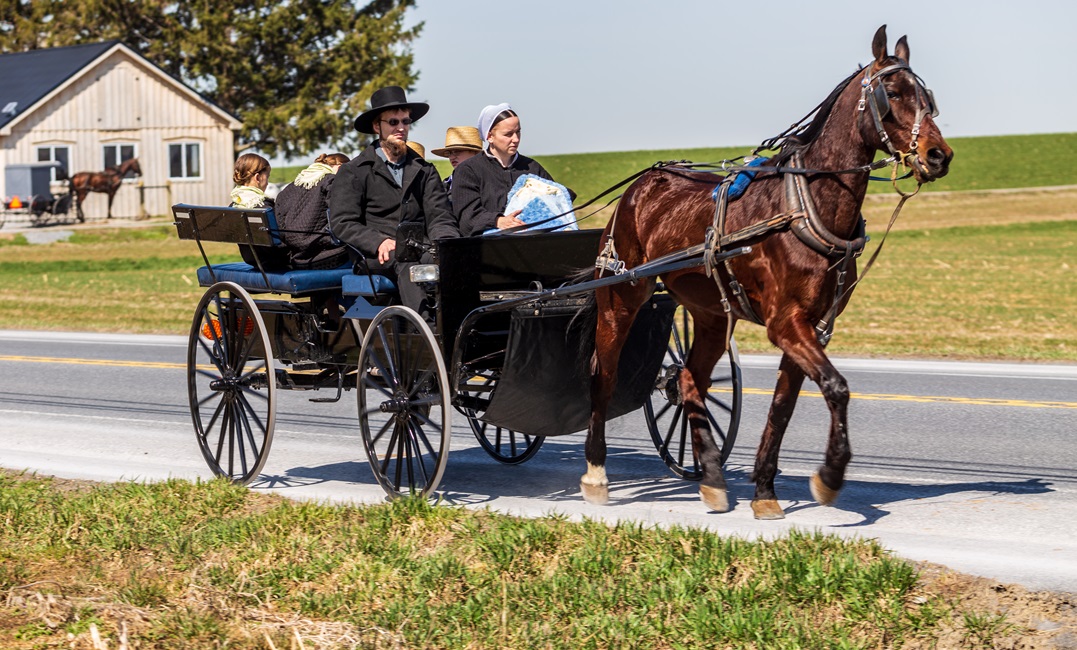by Laura Jones
Published on October 20, 2023
The Amish are famous for their simple way of living and deeply rooted traditions. Their distinctive dress and penchant for traveling by horse-drawn carriage make them easy to identify. But one aspect of Amish culture always seems to confuse outsiders: their language.
Do the Amish speak German, English or Dutch? While many Amish can speak several languages, the language most associated with the group is Pennsylvania Dutch. Also known as Pennsylvania German, this unique German dialect (or, really, group of dialects) has very little to do with the Dutch spoken in the Netherlands. In this guide, we’ll review its origins and basic characteristics.
Before diving into the language, let’s take a brief look at who the Amish are. The Amish are members of a conservative Christian faith who left Europe in the early 1700s to escape religious persecution.
The first members of the Amish community in North America came from an area in Southwest Germany called the Palatinate, and they settled mainly in Pennsylvania. Later, more Amish people migrated to the United States from Switzerland.
So, are the modern-day Amish still German? Many people in the Amish community have German roots, but in many cases their families have lived in the US for centuries. This means they’ve established a distinct identity all their own. In fact, the Amish in the US aren’t even a completely unified group, having split into four communities with different beliefs.
Many Amish people speak a German-descended language known as Pennsylvania Dutch.
The term “Dutch” is not neatly derived from Deutsch (German), as many people assume. “Dutch” as an English adjective was once used primarily to describe people from Germany and the Netherlands. That connotation of the term stuck around and continues to be used to describe the Amish and their language today.
Pennsylvania Dutch is based on an old form of German and has evolved to include many English words. It differs from High German, which is mainly used in the Amish Bible.
So, if you speak German, will you be able to understand Pennsylvania Dutch? You’ll probably understand some of it, but not everything. (If you speak English as well as German, you’ll understand even more!)
Here are some words in Pennsylvania Dutch:
| Pennsylvania Dutch | English | Modern German |
| Reggeboge | rainbow | Regenbogen |
| Kie (pronounced “key”) | cows | Kühe |
| Gmee | church | Kirche |
| Frieyaahr (pronounced “Free-yawr”) | spring (the season) | Frühling |
Yes, a number of dialects exist within Pennsylvania Dutch.
As with most languages, Pennsylvania Dutch is not a uniform language, though all of its dialects are generally mutually intelligible. The Amish in Ohio tend to speak differently from those in New York and Pennsylvania, where a dialect more similar to Swiss German is often spoken.
Knowledge of Pennsylvania Dutch is passed down orally from generation to generation. Children grow up hearing and speaking Pennsylvania Dutch at home. English is typically introduced when they start their formal schooling, which lasts until the eighth grade. Hence, most Amish are bilingual, fluent in both their native dialect and English.
Pennsylvania Dutch is the primary language for everyday life within the Amish community.
English is often used for business interactions, or when dealing with non-Amish individuals. However, some younger Amish people speak mostly English, using just a few words of Pennsylvania Dutch.
Older generations usually predominantly speak Pennsylvania Dutch.
The Amish community’s commitment to tradition and their isolated way of living have helped to preserve their dialect. However, as noted above, younger Amish people are using more and more English. This means that the future of Pennsylvania Dutch is a bit uncertain, though it will likely continue to be spoken among the most dedicated adherents to the Amish lifestyle.
Thanks to their German-speaking ancestors, the Amish speak a dialect rooted in German but uniquely their own. If you want to hear Pennsylvania Dutch spoken in the US, take a trip to Amish areas of Ohio, Pennsylvania or New York State. If you speak German, you’re sure to understand some of the vocabulary.
